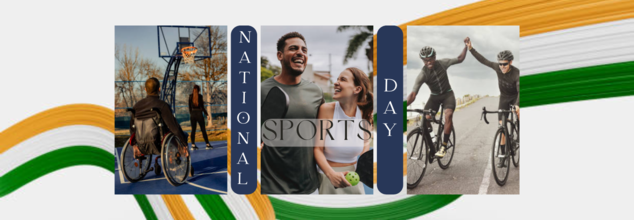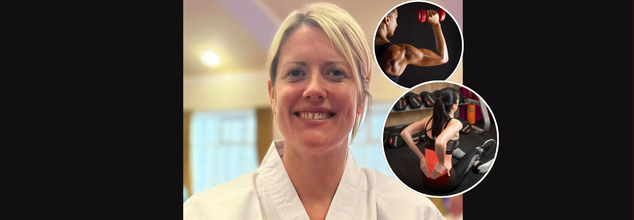- Health Conditions A-Z
- Health & Wellness
- Nutrition
- Fitness
- Health News
- Ayurveda
- Videos
- Medicine A-Z
- Parenting
- Web Stories

National Sports Day 2024: Theme, Significance And Impact Of Sports On Your Health And Happiness
National Sports Day is celebrated in India on August 29th every year, commemorating the birth anniversary of hockey legend Major Dhyan Chand. This day honors his legacy and emphasizes the importance of sports and physical activities in daily life. In 2024, the theme focuses on "Inclusivity in Sports: Bridging Gaps and Breaking Barriers," highlighting the essential role of sports in fostering unity, equality, and well-being across different communities and individuals, regardless of their gender, physical abilities, or background.
The celebration of National Sports Day serves as a reminder of the transformative power of sports in our lives. It is not just about physical prowess but also about mental resilience, emotional balance, and social cohesion. As we delve into the theme for this year, it becomes crucial to understand how sports contribute to holistic health, including physical, mental, and emotional aspects, while promoting inclusivity and breaking down societal barriers.
Significance of National Sports Day
National Sports Day holds a special place in India’s calendar, symbolizing the country’s deep-rooted love for sports. Major Dhyan Chand, whose birthday the day commemorates, is often hailed as one of the greatest hockey players in the world. His contributions to Indian sports have left an indelible mark, inspiring generations of athletes. The day is not only a tribute to his legacy but also an opportunity to encourage more people to participate in sports, recognizing its significant benefits.This year's theme, 'Inclusivity in Sports: Bridging Gaps and Breaking Barriers,' highlights the ongoing efforts to make sports accessible to everyone. It underscores the importance of creating an environment where people of all genders, ages, and abilities can engage in sports activities without facing discrimination or limitations. This inclusivity is vital for a healthier society, as it promotes equality, unity, and shared experiences.
National Sports Day 2024: Theme
The theme for National Sports Day in 2024 is 'Inclusivity in Sports: Bridging Gaps and Breaking Barriers'. Inclusivity in sports is a critical issue that has gained more attention in recent years. Historically, sports have been dominated by able-bodied men, with women, differently-abled individuals, and marginalized communities often excluded or underrepresented. The theme for National Sports Day 2024 emphasizes the need to address these inequities and create opportunities for all individuals to participate in sports.Efforts are being made to ensure that sports facilities, programs, and events are more inclusive. This includes providing resources and support for women in sports, ensuring that people with disabilities have access to adaptive sports programs, and creating safe spaces for marginalized communities to engage in sports activities. By doing so, sports can become a powerful tool for social change, helping to break down barriers and foster a more inclusive society.
The challenges faced by women and individuals with disabilities in sports are well-documented. Women athletes often struggle with unequal pay, lack of sponsorship, and inadequate facilities, while people with disabilities may face physical and societal barriers that prevent them from participating in sports. However, with increased awareness and advocacy, there has been a gradual shift towards more inclusive practices, ensuring that everyone, regardless of their gender or physical abilities, can experience the joy and benefits of sports.
Impact of Sports on Physical Health
The physical benefits of sports are well-known and widely acknowledged. Regular participation in sports can help individuals maintain a healthy weight, improve cardiovascular health, and increase strength and endurance. Engaging in physical activities also reduces the risk of chronic diseases such as diabetes, hypertension, and obesity. Moreover, sports can help in enhancing flexibility, coordination, and overall physical fitness.In addition to these benefits, sports also play a crucial role in promoting healthy aging. As individuals grow older, maintaining an active lifestyle becomes increasingly important. Regular physical activity, including sports, can help older adults preserve their muscle mass, improve their balance, and reduce the risk of falls. It also contributes to better bone health, which is particularly important for preventing osteoporosis and fractures.
The impact of sports on physical health is not limited to competitive athletes; it extends to people of all ages and fitness levels. Whether it's a child playing in a schoolyard, an adult participating in a recreational league, or an older adult taking part in a senior fitness program, sports provide an enjoyable and effective way to stay active and healthy.
Mental and Emotional Benefits of Sports
Sports are not only beneficial for physical health but also have a profound impact on mental and emotional well-being. Regular participation in sports has been linked to improved mental health outcomes, including reduced symptoms of depression, anxiety, and stress. Engaging in physical activities triggers the release of endorphins, the body's natural mood elevators, which contribute to a sense of happiness and well-being.
Moreover, sports can help individuals develop important life skills such as teamwork, leadership, and discipline. These skills are not only valuable on the field but also in everyday life. For children and adolescents, participating in sports can boost self-esteem, foster social connections, and provide a sense of belonging. For adults, sports can offer a healthy outlet for stress and a way to build and maintain relationships.
The emotional benefits of sports are also significant. Engaging in sports provides a sense of achievement and purpose, which can be particularly important during challenging times. Whether it's the thrill of scoring a goal, the satisfaction of completing a challenging workout, or the camaraderie of being part of a team, sports can provide a much-needed emotional boost.
5 Ways You Can Add Sports-Related Activity in Your Daily Life
Here are five simple ways to add sports into your daily life:
Morning Jog or Run: Start your day with a 20-30 minute jog or run in your neighborhood or local park to boost your energy and fitness.
Join a Local Sports Team: Sign up for a recreational sports team, like soccer, basketball, or volleyball, to stay active and socialize with others.
Lunchtime Walks: Use your lunch break for a brisk walk or quick workout, like stretching or light exercises, to break up your day.
Home Workouts: Set aside 15-20 minutes for a home workout routine, such as yoga, pilates, or bodyweight exercises.
Weekend Sports Activities: Dedicate weekends to outdoor sports activities like cycling, swimming, or hiking to stay active and enjoy nature.
National Sports Day is more than just a celebration of athletic achievements; it is a reminder of the profound impact sports can have on our lives. From improving physical health to enhancing mental and emotional well-being, sports offer a wide range of benefits that contribute to a healthier, happier, and more inclusive society. As we celebrate this day, let us recognize the importance of making sports accessible to everyone and commit to creating a more inclusive and equitable environment for all.
With the theme of "Inclusivity in Sports: Bridging Gaps and Breaking Barriers," we can work towards a future where everyone, regardless of their background or abilities, can experience the joy and benefits of sports. Let this National Sports Day inspire us to come together, support one another, and continue to promote the power of sports for holistic health and well-being.

Fitness Freak Nearly Dies After Common Exercise Mistake; Here's What She Did Wrong
Exercise is the key to good health, but as with anything—even water or vitamins—too much of a good thing can be dangerous. For 41-year-old Gemma Underwood, a Scottish fitness enthusiast and orange belt in karate, her passion for training nearly cost her life. What started as an “intense” martial arts session led her down a frightening path to the emergency room, where she was diagnosed with a rare and potentially deadly condition called rhabdomyolysis. Her story is a sobering reminder for gym-goers and athletes everywhere: fitness without balance can be fatal.
It was just another training day in March for Underwood in South Ayrshire, Scotland. Her karate session had been grueling, pushing her physical boundaries, but she felt satisfied—until the next morning. Unable to get out of bed due to severe muscle pain and swelling, she noticed her arms had ballooned, and her muscles were extremely tight. But the most alarming sign was what she saw in the bathroom mirror: her urine had turned a disturbing dark brown, which she described as resembling “Coca-Cola.”
Panicked and confused, Underwood rushed to the emergency room. Medical professionals quickly diagnosed her with rhabdomyolysis, often referred to as “rhabdo,” a serious condition involving the breakdown of muscle tissue that releases toxic proteins—specifically myoglobin—into the bloodstream. If untreated, these proteins can clog the kidneys, leading to kidney failure or even death.
What is Rhabdomyolysis?
Rhabdomyolysis is not commonly discussed in mainstream fitness conversations, but it’s a well-known risk among medical professionals and elite trainers. According to the Cleveland Clinic, rhabdo occurs when skeletal muscle breaks down rapidly due to extreme physical exertion, trauma, or dehydration. As muscle fibers die, they release their contents into the bloodstream, overwhelming the kidneys and potentially causing multi-organ failure.
Symptoms vary and can be deceptively mild in early stages. They typically include:
- Muscle pain, swelling, or tenderness
- Weakness or difficulty moving limbs
- Fatigue or malaise
- Nausea or vomiting
- Significantly reduced urination or dark-colored urine (a major red flag)
In Underwood’s case, the condition escalated quickly—an all-too-common reality when the signs are misunderstood or ignored. Doctors told her the cause was likely inadequate hydration during her intense workout. “I wasn’t hydrated enough,” she admitted. “I should have been drinking more water before.”
Water plays a vital role in preventing rhabdomyolysis. Without enough fluids, the kidneys struggle to flush out myoglobin and other harmful muscle breakdown products. During strenuous exercise, particularly in high-heat environments or lengthy sessions, fluid loss through sweat increases dramatically. If not replenished, the body enters a state of dehydration, magnifying the impact of muscle strain.
Despite being fit and experienced, Underwood made the critical mistake of underestimating her hydration needs—a mistake that nearly proved fatal.
Underwood spent five days in the hospital receiving intravenous fluids and was fitted with a catheter to monitor kidney function. She’s now on a mandatory exercise hiatus for at least three weeks and has made hydration a top priority.
“I’m currently resting, no exercise at all, and drinking plenty of fluids,” she shared. “It was terrifying knowing I could’ve died from something that seemed so routine. Make sure you're hydrated before any workout, no matter how intense it is.”
Her message is clear: no one is immune to the dangers of overtraining. Her story is a cautionary tale not just for elite athletes but for anyone who steps into a gym or takes on a new fitness challenge without adequate preparation.
How to Exercise Smart and Stay Safe?
While rhabdomyolysis is rare, it’s becoming increasingly common among high-intensity workout communities, especially in CrossFit, spin classes, and boot camps where participants are encouraged to push limits. The good news? It’s entirely preventable.
Here’s what every exerciser should remember:
Hydration is non-negotiable: Drink water before, during, and after workouts. Electrolytes help too.
Ease into new routines. Whether you’re new to fitness or returning after a break, increase intensity gradually.
Listen to your body. Pain and fatigue are signals, not challenges to override.
Know the symptoms. Dark urine, severe swelling, and unexplained weakness are not to be ignored.
Rest and recovery matter. Muscles grow and repair when you rest—not when you overtrain.

Credits: Canva
What Is Fartlek? The Simple Running Trick Backed By Science To Supercharge Your Stamina
Whether you’re training for your first 5K or looking to smash a marathon PR, fartlek could be the game-changing workout your running routine is missing. Fartlek is Swedish for “speed play,” this unique running method blends freedom with structure, play with performance, and science with simplicity and it might just be your secret weapon for endurance, speed, and improved cardiovascular health.
Fartlek training was invented during the 1930s by Swedish Olympic trainer Gösta Holmér, who was looking for a method to make his athletes faster and more resilient without the tedium of repetitive exercise. In contrast to regular interval training, in which recovery periods are specifically set, fartlek promotes ongoing movement with changing intensity alternating sprints of speed with slow recovery runs, all without stopping.
This "playful" approach not only wards off boredom but also provides a smooth transition between base running and more formal speed work. It's a method that encourages spontaneity while enjoying serious physiological rewards.
What Exactly Is a Fartlek Run?
Fundamentally, fartlek is a type of unstructured speedwork. In a fartlek session, you vary between harder and easier running, but in contrast to intervals, there are no full rest pauses. You may sprint for one minute, jog for three, run hard to the next tree, then recover until the next lamppost.
You can create your own rules based on either time or distance. For instance:
- 1 minute fast, 3 minutes easy
- Half a mile fast, half a mile recovery jog
Why Fartlek Training Works?
Fartlek is not merely a curiosity of bygone days. It's grounded in exercise physiology that makes sense of its utility for building cardiovascular endurance, lactate threshold, and muscular economy. Since the "recovery" periods are still working hard, your heart rate stays high, putting extra stress on your aerobic system — which is a potent tool in the hands of long-distance runners and recreational joggers alike.
Further, pace variation also enhances the ability of your body to recycle lactate, with an overall energy expenditure. Fartlek training serves to condition your body to excel in conditions experienced in real races, where the pace can constantly change with the terrain, competitors, or wear and tear.
For novices or runners coming back from a break, fartlek provides an easy point of entry to increased-intensity work. With no stopwatch or track required, it eliminates intimidation and lets you tap into your perceived effort. You're not tied to strict measures — you just run by sense.
That flexibility is also what makes fartlek perfect for use in initial stages of a training cycle. It gets the mind and body ready for more organized sessions in advance, without burning them out.
Fartlek vs. Other Speed Workouts
Let's discuss how fartlek is different from tempo runs and interval training:
Tempo runs: Consistent runs at a "comfortably hard" rate — usually around 20–45 seconds slower per mile than your 5K pace. They develop lactate threshold but lack the same variability as fartlek.
Intervals: High-intensity efforts with full recovery or slow recovery (e.g., 8 x 400m with full recovery). They're more structured and performance-oriented than fartlek.
Fartlek: Balances speed and endurance without full rest. Less predictable, more flexible — and sometimes more fun.
Why You Need to Add Fartlek into Your Training?
1. It Mirrors Race-Day Reality
Races are not run at a set pace with prearranged recovery periods as with intervals. Fartlek simulates the unpredictable nature of racing — surges, hills, and tactical fluctuations — making you more resilient.
2. It Educates Self-Regulation
By allowing you to control when to accelerate and decelerate, fartlek training develops body awareness. You'll discover how to monitor effort, deal with fatigue, and adjust pace — essential skills for any distance runner.
3. It's Efficient and Convenient
With hectic lifestyles, sometimes all you can manage is 20–30 minutes. A short fartlek session over lunch or on a nearby trail can bring significant payback in a concise manner.
4. It Keeps Things Fun
Running doesn't have to be all about numbers. Fartlek brings some spontaneity into your routine. Skip the GPS watch, select a scenic route, and let your instincts dictate your pace.
Key Fartlek Workouts to Try
1. Free-Form Fartlek
Select a natural route and perform 10–25 short bursts (15 seconds to 4 minutes) with steady running in between. Use landmarks as your navigation.
2. Bridging Fartlek
Perfect early in a training plan: attempt 10 reps of 30 seconds hard, 90 seconds steady — building over time to 1-minute hard, 1-minute steady.
3. Mixed Paces
Develop endurance with decreasing intervals: 6, 5, 4, 3, 2, 1 minutes — increasing the pace as you go, with 90 seconds of slow running in between attempts.
5. Marathon Prep Fartlek
Alternate 3 minutes slower than marathon pace with 3 minutes faster for 60 minutes of a longer 75–90-minute run.
Fartlek training may not receive the same banner headlines as high-tech interval training or boutique studio classes, but its very simplicity is its genius. Supported by decades of practice and current science, this vintage approach continues to pay dividends in stamina, speed, and aerobic fitness while keeping running interesting and enjoyable.

(Credit-Canva)
Build Better Balance With These Yoga Poses Tips
Yoga poses may seem easy to do, or something that should not require a lot of strength and endurance. However, the people who do practice yoga know that not only do you need good strength, endurance, but also focus and balance. Even for basic poses, one needs a semblance of control over their movements and enough balance to hold the poses for a period.
Here Are Ways To Enhance Your Stability In Yoga Poses
You can improve your balance in yoga while you're still working on it. You just need to give yourself some time to learn. These tips can help you feel steadier in your yoga practice, whether you feel shaky just standing or you're aiming for more advanced one-legged poses.
Feel the Floor
Yoga teachers say "ground into the mat." For beginners, feel a strong link between your body and the floor. Like a building needs a good base, pay attention to your toes, the balls of your feet, and heels pressing down. Gently lift the middle of your feet to feel steady.
No Socks, No Shoes
Your balance uses your eyes, ears, and how your feet feel the ground. Taking off socks and shoes lets the bottom of your feet directly touch the mat. This feeling helps your body know how to stay balanced.
Body Like Building Blocks
After feeling the floor, focus upwards. Think of your body as blocks stacked on each other. Start with your feet and line up your ankles, knees, and hips. Keep your spine straight and your shoulders over your hips, reaching the top of your head up.
Wake Up Your Muscles
Standing in yoga needs your muscles to be active, not floppy. Use the small muscles in your feet, legs, and your core (belly, back, and glutes) to help you stay steady. Pushing down through your heel can help turn these muscles on.
Look at One Spot (Drishti)
To balance better, look at one still thing straight ahead. This is called drishti. If you're wobbly, pick a spot on the wall and keep looking at it. This helps your eyes and inner ears keep you steady.
Use Your Middle
Remember to use your whole middle part, your back and butt muscles too, not just your belly, to help you balance. Keeping these muscles firm helps your spine and hips stay still, making your whole body more stable.
Keep Breathing Slowly
When you're balancing, pay attention to your breath. Breathe in and out slowly and focus on it. This helps you stay in the moment and keeps your mind from wandering, which helps you stay balanced.
Use a Little Help
It's okay to use support, like training wheels on a bike. If you're learning or having a bad day, practice near a wall or chair so you can hold on if you start to wobble.
Widen Your Feet
If you feel shaky when standing with both feet down, try putting them a little wider apart, like hip-width. This makes your base bigger and more stable. Imagine standing on train tracks, not a tightrope.
Start Easy
You don't have to do hard one-legged poses right away. Practice feeling steady in simple standing poses first. Maybe try just lifting one knee up for a bit. Be patient with yourself; balance takes time and practice.
© 2024 Bennett, Coleman & Company Limited

